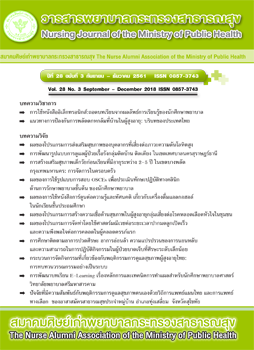The Development of a Care Model for Home-bound and Bed-bound Chronically ill Patients
Main Article Content
Abstract
The purpose of this action research was to develop the care model for home-bound and bed-bound chronically ill patients in Suratthani Municipality. The research had three phases, 1) analyze the situation of the chronically ill patient who was home-bound and bed-bound, 2) develop a care model and 3) evaluation of the implementation of the model before and after. The samples were135 home-bound and bed-bound patients and 22 members of the team provided care for chronically ill patients. The tool of the study was a semi-structured interview questionnaire which was used to interview and a focus group. The Barthel’s ADL and the patients’ perception of health questionnaires were used to evaluate before and after the development of the care model. The reliability of questionnaires were .76 and .97. Descriptive statistics were used such as percentage, mean and SD. Inferential statistics including Wilcoxon Matched pairs signed rank test were used. The results of the team development showed five topics that developed the care model for chronically ill patients who were home-bound and bed-bound. These were 1) The development of the potential care team 2) The development of a follow-up system 3) The implementation of participation of the patient care network 4) Self care support and 5) Social support.
The results of the care model’s development for 135 chronically ill patients who were home-bound and bed-bound found capable of performing basic tasks at the significance level of .05 (w=-2.122).
Article Details
บทความและรายงานวิจัยในวารสารพยาบาลกระทรวงสาธารณสุข เป็นความคิดเห็นของ ผู้เขียน มิใช่ของคณะผู้จัดทำ และมิใช่ความรับผิดชอบของสมาคมศิษย์เก่าพยาบาลกระทรวงสาธารณสุข ซึ่งสามารถนำไปอ้างอิงได้
References
2. Social medicine department, Suratthani hospital. Reported number of chronically ill patients 2015. Surat Thani Province; 2016.(in Thai)
3. Foundation of Thai Gerontology Research and Development institute. The situation of Thai Older Persons. [Internet]. 2014.[cited 5 April 2016]. Available: www.thaitgri.org /?p =36746.
4. Ministry of Public Health. The situation and severity of NCDs. [Internet]. 2016.[cited 14 December2016]. Available: 5/%%5/%%5/%%5/%%5/%%5/%www.thaihealth.or.th/microsite/content/5/neds/181/34433.
5. Registration and Identification Card Section. Population Report in Suratthani Municipality. Suratthani Municipality Office; 2015. (in Thai)
6. Health Care Center, Bungkhunthale. Reported number of chronically ill patients 2015. Suratthani Municipality; 2015.(in Thai).
7. Phuaksawat, P. Situations, problems, and health care needs for home-bound and bed-b
8. Department of Health. Barthel Activities of Daily Living: ADL. Ministry of Public Health Ministry of Public Health; 2012. (in Thai)
9. Ware JE, Sherbourne CD. The MOs 36 items short form health survey (SF 36): Conceptual framework and item selection. Medical Care 1992;30(6):473-83.
10. Ngoichansri. J, and Kongtaln. O. Development of Continuing Care for the Home - Bound and Bed – Bound Eldersin Phetchabun Municipal Community. [Master thesis] Khon Kaen: Khon Kaen University. 2012. (in Thai)
11. Bloom. Bloom’s Taxonomy. [Internet]. 2016.[cited 14 December2016]. Available: https://sirikanya926.wordpress.com
12. Boonles. P. Continuous care model development for disability elders in Bandongmone health promotion hospital Tumbon Singkok Aumphur Kasetwisai Roi-Et Province. Journal of the Disease Prevention Control. 2016;23(2),79-87(in Thai).
13. Sumangsri S. Development of the continuous care guidelines for the home - bound and bed bound elders living in the Vicinity of Family Practice Center, Phra Nakhon Si Ayutthaya Hospital 2015;5(1):53-4.
14. Vinijkul S. and Suckchaisong, N. Effects of a Community Participation Program Approach on the Health Promoting Behavior and Self-care Behavior Among Chronic Disease Patients in Community.[ Internet ]. 2013.[ cited 24 May 2016]. Available: www.ken.ac.th/KEN- Journal/Journal/22556/Job%2020140226 607.pdf.
15. Aujongprasit S. Involvement of People.Bangkok: Samcharoenpanit. 2008.(in Thai)
16. Thamnamsean, K. Effect of self - care promoting program on self – care behavior among older adults with Uncontrolled Hypertension in Bangkok Metropolitan. Journal of the Ministry of Public Health Nursing. 2015;29(2). (in Thai)
17. Sanit U. The Effects of Self-Care and Social Support to Reduce Stress of Type 2 Diabetic Patientis at Sukkasem Health Promoting Hospital,Kudchum District,Yasothon Province. [ Internet ] 2011. [cited 24 August 2016]. Available: rdhsj.moph.go.th/62/662/22.pdf
18. Suksripeng B. Orem ‘s self care Theory.[Internet].[ cited 3 May 2016] Available: qrad. vru.ac.th/meeting_board/2555-03-meeting/CID/Chon/3Paltanee2.pdf.
19. Thaveegasikum Y. Related to Quality of life among Thai caregivers of the chronic disease patients with Dependency in Manorom District, Chainat Province. Nursing Journal of the Ministry of Public Health.2012;31(1), 104-17.
20. Auprala, R. Effectiveness of an evidence-based intervention on level of strain experienced by caregiver of stroke patients in Thailand. Rajiabhat Journal of Sciences, Humanities&Social Sciences, Lf;12(2).
21. Berkman,Ls,. Glass. T.(2000). Social inteqration, Social network, and health In L.F., BerkmandI. Kawachi (Eds.), Social epidemiology. New York: Oxford University Press.

